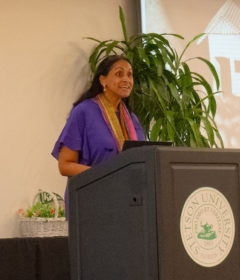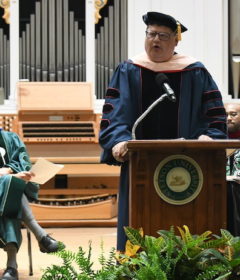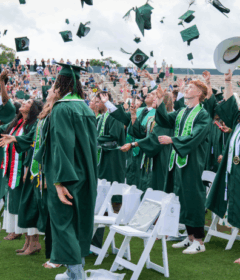Celebrating 140 Years: 1983-1992, Decade Of President Lee and the Lynn Business Center
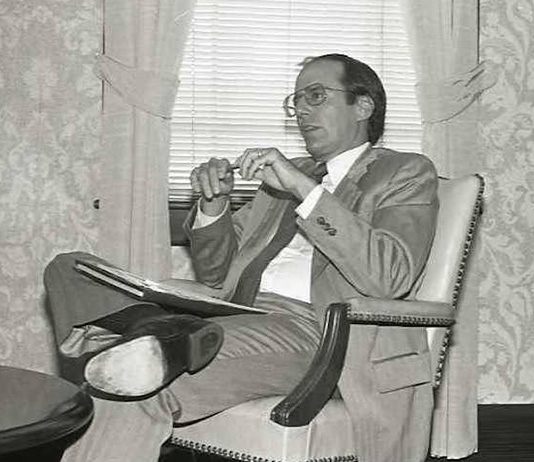
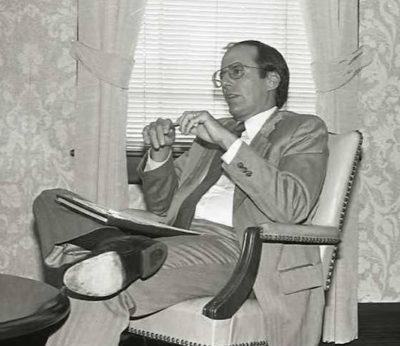
In 1987, the average cost of a new house in the United States was $92,000, and the average monthly rent was $395. At the gas pump, one gallon of gas was 89 cents, and in grocery stores one dozen eggs was 65 cents.
And at Stetson in 1987, H. Douglas Lee became the university’s eighth president.
While there are no coincidence, the economic circumstances do put in perspective just how meaningful Lee’s time was during this decade on campus.
Lee graduated from the University of Richmond and received advanced degrees in Theology from Southeastern Seminary and Religion and Ethics from the University of Iowa. After serving as an administrator and professor of religion at Virginia Intermont College then Wake Forest University. Lee arrived at Stetson as vice president for Development in 1978.
Under his leadership as president, various buildings were added, including Griffith Hall, the Hollis Center, the Wilson Athletic Center, the Lynn Business Center, new dormitories, the Hand Art Center, McMahan Hall and the Rinker Environmental Learning Center.
Highlights of the Lee administration include the $200 million fund campaign, the opening of the Center at Celebration, the construction of Melching Field at Conrad Park (baseball stadium), the expansion and renovation of both the duPont-Ball Library and Sage Hall, the inauguration of the Institute for Christian Ethics and the Howard Thurman Program (established to integrate the works of scholars and community leaders to seek solutions to social, religious and ethnic problems) and the creation of the University Values Council. Additionally, H. Lee served as president during the time when the university parted ways with the Florida Baptist Convention.
Lee retired in 2009 and was named chancellor of the university. He died unexpectedly a few months after his retirement.
Lynn Business Center
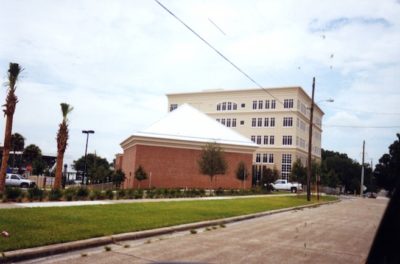
In 1990, Stetson purchased what is now the Lynn Business Center, with funds donated by Eugene M. Lynn, a Boca Raton insurance executive. The intention was to provide a high-tech business school to accommodate enrollment growth in that academic area. The rundown, six-story bank building was gutted to begin a 18-month renovation project.
Natural light was an immediate featured component of the remake, particularly through an atrium that was carved into the center of the building. The renovated building contained classrooms, conference rooms/classrooms, faculty offices and other meeting rooms. Synthetic stucco and high-performance glass were used for the building’s exterior. Two adjacent brick buildings housed an auditorium and multiuse spaces. Those buildings, with sloped metal roofs, blended contextually with other campus aesthetics.
In 2002, the university committed to another massive renovation, and a year later the Lynn Business Center received Leadership in Energy and Environmental Design (LEED) certification from the U.S. Green Building Council. That distinction made the building a national showcase of sustainable design that combines environmentally sensitive planning, siting, architectural design and energy-efficient building systems. It was the first building in Florida to be certified as a green building by the U.S. Green Building Council.
Fast forward to 2023, and Stetson is once again included in The Princeton Review’s list of Green Colleges, which recognizes the nation’s most environmentally responsible institutions.
Learn more about Stetson’s 140-year anniversary and join in on the celebration throughout the fall.
-Michael Candelaria and Stetson University Archives

